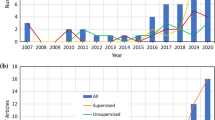Abstract
Ground subsidence in underground coal mining areas causes environmental damage and creates hazards on the ground surface, which is long-term, widely distributed, and can lead to large-scale geological disasters. Achieving a high-precision method to predict mining subsidence deformation is very important for assessing environmental damage and countermeasures. In this paper, based on the “S”-type settlement curves of the monitoring points in the collapsed pit and the failure mechanism of rock strata on the goaf, the arc tangent function model was proposed and applied to the Taihe coal mine in Fushun, Liaoning Province, China. Using the Levenberg–Marquardt algorithm for nonlinear curve fitting of the data, the parameters of the model are obtained, and extending it in time, the prediction function will be obtained. Using different monitoring data to validate the model shows that the accuracy of the medium- and short-term forecasting is very good. With continuous updating of the monitoring data, the forecasting achieves higher accuracy and the function of dynamic track forecasting is achieved. A very high correlation coefficient was obtained (0.996) using all the available data from the monitoring point for the best-fit curve. This prediction model provides a reference for the evaluation and treatment of ground subsidence in the Taihe coal mining area.






Similar content being viewed by others
References
Chengdong S, MingGu X, Guo W (2012) The study of the compaction characteristics of the broken rock of coal seam rood. J rock mech eng 31(1):1140–1144
Lee S, Park I, Choi J-K (2012) Spatial prediction of ground subsidence susceptibility using an artificial neural network. Environ Manage 49:347–358
Levenberg K (1944) A method for the solution of certain non-linear problems in least squares. Q Appl Math 2(2):164–168
Li G, Zhang H, Li H (2013) The comparative analysis of probability integration and numerical simulation in surface subsidence prediction. Appl Mech Mater 295–298:3015–3018
Lourakis MIA (2005) A brief description of the Levenberg–Marquardt algorithm implemented by levmar. Found Res Technol 4:1–6
Marquardt DW (1963) An algorithm for the least-squares estimation of nonlinear parameters. J Soc Ind Appl Math 11(2):431–441
Nie L, Zhang M, Jian H (2013) Analysis of surface subsidence mechanism and regularity under the influence of seism and fault.Nat Hazards 66:773–780
Saeidi A, Deck O, Al Heib M, Rouleau A (2013) Adjusting the influence function method for subsidence prediction. Key Eng Mater 553:59–66
Wang J (2003) The analysis of the prediction of the landslide. Chin J Geol Hazard Control 14(2):1–8
Williams S, Bock Y, Pang P (1998) Integrated satellite interferometry: tropospheric noise, GPS estimates and implications for interferometric synthetic aperture radar products. Geophysics 103(11):27051–27067
Xu N, Kulatilake PHSW, Tian H, Wu X, Nan Y, Wei T (2013) Surface subsidence prediction for the WUTONG mine using a 3-D finite difference method. Comput Geotech 48:134–145
Xu H, Liu B, Fang Z (2014) New grey prediction model and its application in forecasting land subsidence in coal mine. Nat Hazards 71:1181–1194
XunChun W, Yue Z, XingGe J, Pengl Z (2011) A dynamic prediction method of deep mining subsidence combines d-insar technique. Procedia Environ Sci 10:2533–2539
Zhang J, Chong L (2012) The discussion of the surface and building deformation in the coal mining subsidence area. Shanxi Archit 38(9):83–84
Zhao J, Sun Z, Zhang Z, Liu T (2010) A brief analysis of the collapse mechanism and development factors of the multilayer goaf. Gr Water 32(2):158–161. doi:10.3969/j.issn.1004-1184.2010.02.067
Acknowledgments
This project was financially supported by the Basic Research Foundation of Jilin University (Grant No.201103139). Special gratitude is also extended to those participants who have contributed to this work.
Author information
Authors and Affiliations
Corresponding author
Rights and permissions
About this article
Cite this article
Nie, L., Wang, H., Xu, Y. et al. A new prediction model for mining subsidence deformation: the arc tangent function model. Nat Hazards 75, 2185–2198 (2015). https://doi.org/10.1007/s11069-014-1421-z
Received:
Accepted:
Published:
Issue Date:
DOI: https://doi.org/10.1007/s11069-014-1421-z




